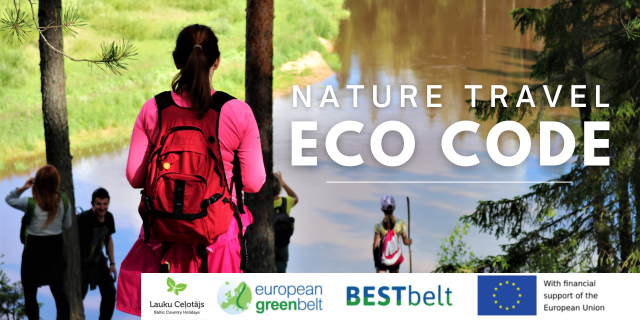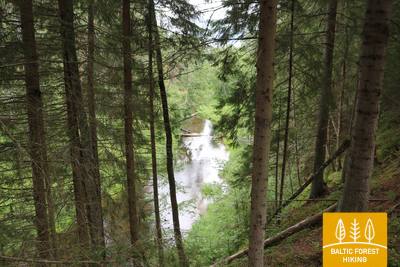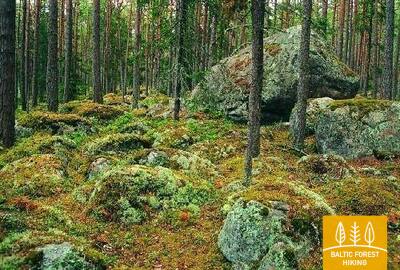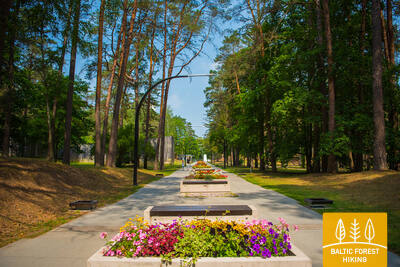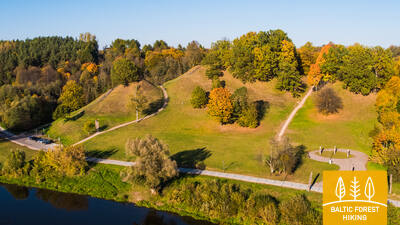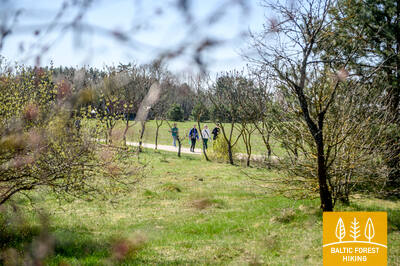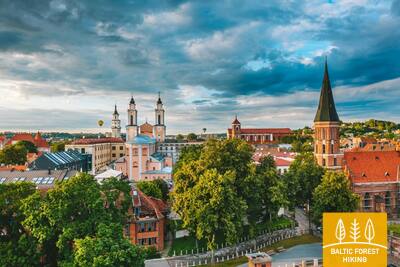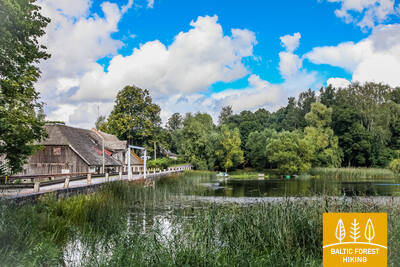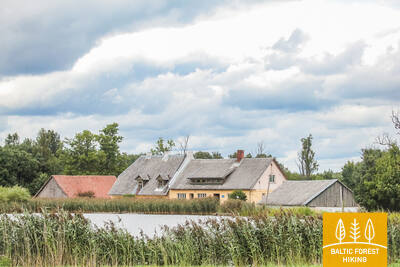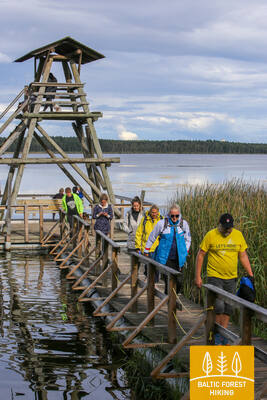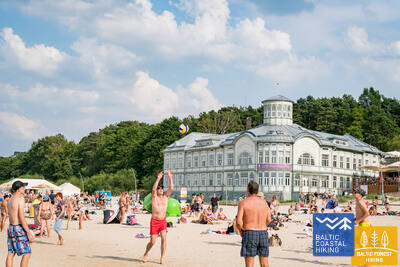Baltic Forest Hiking - Easy hike
 Section 1. Old Riga - Baltezers.
Section 1. Old Riga - Baltezers.
Through Riga – UNESCO World Heritage Site
The starting point of Forest Trail in Latvia is located in the heart of Old Riga, the Town Hall Square. The route leads along Kaļķu Street, passes the Monument of Freedom, through Vērmane Garden and along the historic Tērbatas street. Then it arches over the Zemitāni railway station pedestrian bridge and treads into Biķernieki and Šmerlis forests. The Forest Trail winds through Jugla, passes the Latvian Ethnographic Open-Air Museum and goes on along the pedestrian-bicycle path until Baltezers.
 Section 9. Valmiera - Strenči.
Section 9. Valmiera - Strenči.
Along Abuls to Strenči, the capital of rafters
The trail passes through the historical centre of Valmiera and the Atpūtas Park, which is a popular place among hikers and Nordic walkers, then crosses the suspension bridge, passes Pauku priedes pine forest and Baiļu kalns. From there it follows the Abuls Trail, curving along the banks of the river until reaching the Brenguļi Brewery, and further down, beyond Pūpoli, enters vast, unpopulated forest areas. The first part of this section passes by numerous small summer cottage villages with names such as Enerģētiķis, Saulītes, Sprīdītis, Gaujmaļi, Pūpoli and Gaujaslāči, which were initially established during the Soviet period as summer cottage neighbourhoods of the people of Valmiera and the surrounding territories. Near Ūdriņas, the Forest Trail leads through a labyrinth of the riverbeds and turns north, crossing the Gauja Bridge, where a resting and boating stop is located. The centre of Strenči is located at a 1.5 km distance. Part of the section passes through the Northern Gauja protected landscape area.
From the so-called 'Dzelzītis' (the former narrow-gauge railway bridge over the Gauja in Valmiera) along the right bank of the Gauja to the Cēsu Street bridge (1.3 km), and further along both banks to the Vanšu Bridge over the Gauja (a loop of about 3 km), you can take short hikes along the Gauja's banks. The Atpūtas Park also has a dense network of trails for easy walks and short hikes.
 Section 42. Oandu‒Käsmu.
Section 42. Oandu‒Käsmu.
Käsmu captains' village and ship building site
The next 9 kilometres of the Forest Trail between Oandu and Võsu coincide with the RMK trail, so be aware of the change of the signs. The trail goes through a beautiful, wooded inland dune area, where hikers can see cuts on pine trees, used to extract resin from the trees. Resin was obtained in the Baltic States using this method up to the 1960s-1970s. Trees are richly covered in lichen, indicating that the air is clean. In autumn, mushrooms and blueberries adorn the edges of the trail. After passing through Võsu village (a popular resort), the Forest Trail continues along a beautiful coastal forest promenade to Käsmu village. It is worth walking an additional extra kilometre to the Vana-Jüri rocks and the historical sites of Käsmu at the tip of the peninsula.
 Section 43. Käsmu‒Viinistu.
Section 43. Käsmu‒Viinistu.
In the kingdom of the giant rocks of the Käsmu Peninsula
The first part of this section passes through the fairytale-like Käsmu Peninsula with its wooded dunes and moss-covered rock fields. From Eru it continues along the Võsu‒Kotka road for 2 km, passes through Vihasoo village and further along the road, from where you can see Eru Bay and the Käsmu Peninsula. The section features some of the most impressive boulders in Lahemaa national park, the Tammispea and Jaani-Tooma boulders, which resemble huge monoliths. From Viinistu, you can spot the Mohni Island and its lighthouse in the distance.
 Section 54. Didžiasalis – Druskininkai – Žiogeliai.
Section 54. Didžiasalis – Druskininkai – Žiogeliai.
Druskininkai – the most popular resort in Southern Lithuania
Between Didžiasalis village and the resort town of Druskininkai, the Forest Trail leads through a coniferous forest with abundant berry and mushroom spots. Before Druskininkai, the Forest Trail merges with the Nemunas road, turns around the Druskininkai Snow Arena and continues along the pedestrian and bicycle path to the Park Bridge across the Nemunas river. After crossing the bridge, the Forest Trail continues on Maironio street. and continues along the small streets of the historic Druskininkai resort and the park roads, crossing the Ratnyčia river and the forest park on the right bank of the Nemunas. The route behind Veisiejai street goes along the sidewalk of Neravų street and after about 1 km turns left into Sodžiaus street, which at the end of Neravai village becomes a beautiful forest road. This is where Dzūkija National Park begins. The Forest Trail turns around Viečiūnai village, opening a beautiful landscape to the Liškiava monastery on the opposite bank of the Nemunas. The Forest Trail then leads to Žiogeliai village along a beautiful secluded forest road.
 Section 57. Nemunaitis – Alytus.
Section 57. Nemunaitis – Alytus.
Across the highest pedestrian bridge to Alytus
From Nemunaitis along Vytauto street and the Kaniūkai–Einorai–Nemunaitis road (no. 1102), the Forest Trail goes 1.5 km in northeast direction, then turns left to the north and after 3 km reaches Gečialaukis village. Then the Forest Trail turns right to the east and after 3.3 km meets the road No. 1102 again. After another 3.3 km, the Forest Trail reaches road No.128 and descends along the sidewalk in the Nemunas valley. From here, a beautiful trail in the Nemunas valley with a length of more than 3 km leads through the forest to a pedestrian bridge across the river. After a long ascent to the highest pedestrian bridge in Lithuania, there opens a view of the endless and mighty landscape of the Nemunas. After the bridge, the Forest Trail passes along the former railway dam, meanders along the streets of the Alytus resort park, and in the centre of the town, along S. Dariaus and S. Girėno street goes to the Old Town Square. The Alytus Tourism Information Center is located on its southern side.
 Section 59. Panemunis – Birštonas.
Section 59. Panemunis – Birštonas.
Nemunas loops and ethnographic farmsteads
Repeating the loops of the Nemunas, the Forest Trail throws more than 20 km long bends in Nemunas Loops Regional Park, winding through open landscapes and small villages with typical wooden buildings painted in different shades. A larger forest massif there is only between Siponiai and Puzoniai villages, through which the route leads along small forest roads. Crossing the Vilnius–Marijampolė road (A16), the Forest Trail descends to the next circle of the Nemunas, where the popular Birštonas resort is located. Along the sidewalk of B. Sruogos street, the Forest Trail reaches the Birštonas Tourism Information Center.
 Section 60. Birštonas – Alksniakiemis.
Section 60. Birštonas – Alksniakiemis.
Through the Birštonas resort
After the Birštonas Tourist Information Centre, the Forest Trail leads for more than 1 km along the Nemunas bank promenade, then turns onto Algirdo street, crosses Vytautas Jurgis Meška Park, returns to the promenade and after 0.6 km turns onto the pedestrian and bicycle path. The path crosses the Žvėrinčiaus forest for about 5 km, and then the leads through the Paprienė recreation area, reaching the Greimų bridge over the Nemunas river. Behind the bridge the Forest Trail moves along the Vytauto, Nemuno, J. Zdebskio, Kęstučio, J. Basanavičiaus streets and along Kęstučio street (No. 3306) exits from the central part of Prienai. Along Paupio street, it forms a loop around the Nemunas and about 7 km from the centre of Prienai turns left to northeast towards Alksniakiemis. Part of this section is located in Nemunas Loops Regional Park.
 Section 64. Kaunas – Lampėdžiai.
Section 64. Kaunas – Lampėdžiai.
Through the historical centre of Kaunas
Kaunas is the second largest city in Lithuania. The 1621 m long Avenue of Freedom (Laisvės Alėja) stands out for its unique modernist architecture – its 1914–1940 buildings has received the European Heritage Label. Vilniaus street is the “gateway” to the medieval city of Kaunas, run by Hanseatic merchants. The Forest Trail runs along Avenue of Freedom (Laisvės Alėja), crosses the Old Town of Kaunas with churches, the Town Hall Square and historical buildings, and throws a circle along Confluence Park (Santakos parkas), where Lithuania's largest rivers, the Nemunas and the Neris, meet. After crossing the Neris river, the Forest Trail continues along the footpaths and bicycle paths to the 4 km distant former Lampėdis gravel quarry, which is flooded and now is a popular place for recreation and swimming.
IMPORTANT. There are no markings where itineraries are crossing the territory of Kaunas city.
 Section 83. Paplatelė – Plateliai.
Section 83. Paplatelė – Plateliai.
Around the largest lakes in the Žemaitija National Park
For the first 3.5 km, the Forest Trail leads through beautiful coniferous forests that cover the slopes of the Žemaitija Upland. Up to the Cold War exposition, it coincides with the Plokštinė cognitive trail. From the museum, the Forest Trail for 5 km follows the Plokštinė road, where a pedestrian / bicycle path has been created and, approaching Plateliai lake, descends into the lowland of the lake. At the road No. 3202 (Malūno street) , the Forest Trail turns left to the south-east and after 0.3 km turns right to right to the south-southwest. After about 0.5 km it reaches Ilgio Ežero street. For the next 5.5 km, the Forest Trail forms a wide circle around Ilgis and Beržoras lakes, reaching the Beržoras village. After the village, after 2 km along Plungės street, the Forest Trail reaches the centre of Plateliai and throws another circle along Ežero street to the beach and Šeirė educational trail. Then along Ežero, Naujoji and Žemaičių Kalvarijos streets, the Forest Trail returns to the centre of the town.
 Section 91. Aizpute – Snēpele.
Section 91. Aizpute – Snēpele.
In the footsteps of baron von Manteuffel
The Forest Trail along Atmodas and Jelgavas streets winds through Aizpute, after the Laža water reservoir turns right, and approaches the Kazdanga manor park with a large circle from the south. As a small path, it leads along Dzirnavu lake through the manor park, around the manor and Zēnu pond, for 0.7 km continues along the Kazdanga–Cildi road (V1200) and then turns right onto the Snēpele–Kazdanga road (V1296). Up to the country house “Zemturi”, the Forest Trail gradually rises in the Bandava hills of the Rietumkursa Upland, revealing beautiful views in both directions. The height of the relief here reaches a maximum of about 81 m above sea level. From “Zemturi”, for about 12 km , the Forest Trail leads through a sparsely populated forest massif and only in the last 3 km comes out again in an open area with agricultural lands and farmsteads, reaching Snēpele.
In Kazdanga Park, which is the largest in Latvia, trails has been created, stretching 9 km in length. The trails are marked, GPX files are available, and rest areas have been set up. More info: https://www.kurzemesregions.lv/projekti/turisms/unigreen/dabas-takas/kazdangas-parka-dabas-taka/
 Section 92. Snēpele – Kuldīga.
Section 92. Snēpele – Kuldīga.
Venta valley and Riežupe Nature Park
Along the main street of Snēpele, the Forest Trail takes the road V1294 and after 0.3 km opposite Ķepšu lake turns right onto a small country road. Along this road, the Forest Trail bends to Slipiņciems, before crossing Sprincupe along the dam, where a pond has been created. Then the Forest Trail goes in the direction of Pelči. Nearby Pelči, the trail bends along Pelču Dambu ponds, leads to the Kuldīga–Pelču road (V1293) and further stretches through the Kuldīga garden areas – “Kurzemīte” and “Rumba”, until it reaches the Venta bank and the Kuldīga bypass. From there to the Old Brick Bridge, the Forest Trail for 2.4 km leads along a beautiful Venta coastal path, where there are wooden bridges and footbridges in wetter places and across streams town of Kurzeme.
 Section 99. Jāņukrogs – Bigauņciems.
Section 99. Jāņukrogs – Bigauņciems.
Through Ķemeri National Park
After crossing the area with some homesteads, the Forest trail winds through beautiful coniferous forests and further 6.5 km along Čaukciems until the turn to the Green Dune leads along the side of the Antiņciems–Smārde road The neighbourhood is flat, as the section is part of the Engure plain of the Piejūras Lowland. The Green Dune (Zaļā kāpa) offers wide views of the Green Bog (Zaļais purvs) and the Witches' Bog (Raganu purvs). A small forest road bends along the lower part of the dune and in two places crosses the bog along wooden footbridges. In Ķemeri, the Forest Trail moves along Partizāna, Robeža, A. Upīša, Katedrāles and E. Dārziņa streets, along the Forest House and Vēršupīte, into which the waters of sulphur springs flow. Crossing Tūristu street, it continues along the Dūņu road to the Sloka lake. Further the trail crosses the Vēršupīte swamp forest, which is one of the most outstanding wet forest habitats in the whole part of the trail in Kurzeme. At Melnezers it turns onto the Old Ķemeri road and after 2 km it reaches Bigauņciems. Behind the Talsi highway, the Forest Trail reaches the shore of the Gulf of Riga and connects with the Coastal Hiking Trail. The Forest Trail runs through the Ķemeri National Park along the entire section.
 Section 101. Dubulti - Lielupe - Bulduri.
Section 101. Dubulti - Lielupe - Bulduri.
The Most Popular Beaches in Latvia
The widest sandy beach of the Gulf of Riga stretches from Dubulti to the Lielupe River. It is the main asset of the Jūrmala resort offering many beach cafés and different recreational possibilities. The coastal dune forests are permeated with a dense web of trails suitable for walking and stick-walking. The part of the Baltic Coastal Hiking Route located between the beach of the Lielupe River and Jūrmala beach is part of the Ragakāpa Nature Park. From here, you can easily get back to Bulduri by taking Bulduri prospekts and the 5th line.









